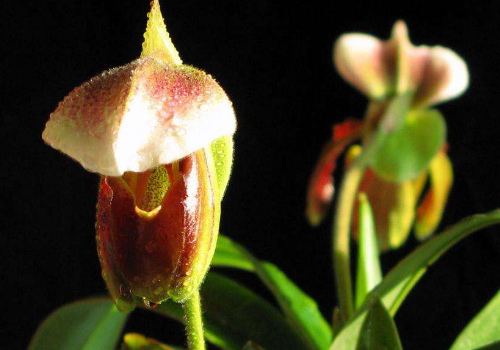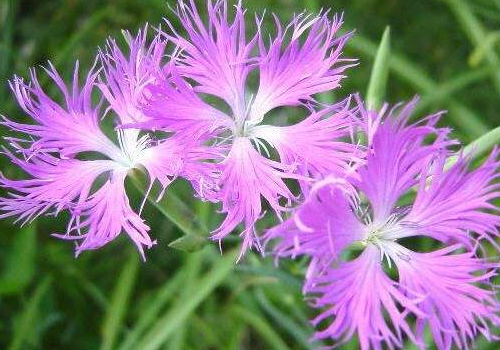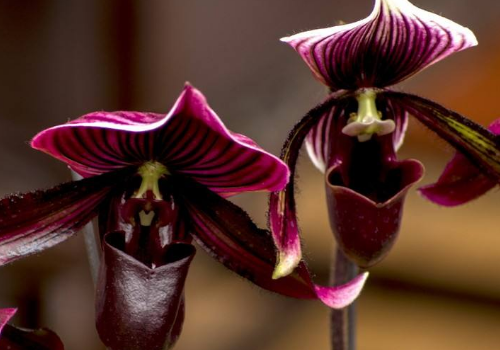Does the cultivation method of Paphiopedilum blossom only once in a lifetime?
Paphiopedilum, this is also a kind of plant, is a lot of people like, the growth is not generally good-looking, so what is the breeding method of Paphiopedilum florescence? Do you only blossom once in your life?
Cultivation methods of Paphiopedilum in flowering stage:
Temperature-controlled shading of Paphiopedilum originates in low latitude and high altitude, so it can not grow normally at too low or too high temperature, especially during winter. The room temperature at night should be more than 10 ℃, and the temperature at daytime should be 5 ℃ to 10 ℃ higher than that at night. Paphiopedilum also likes the sun, but to avoid direct sunlight, cover more than 70% of the sun in autumn and more than 50% in winter, so as to make it blossom well. To maintain humidity, Paphiopedilum likes a humid environment, its drought resistance is too poor, and its florescence is in the autumn and winter dry season, so the pot soil needs to remain moist and often sprinkle water around the flowerpot to maintain high air humidity. If the humidity is not enough, the leaves are easy to turn yellow and wrinkle, directly affecting their flowering.
Appropriate fertilization in the growing period is appropriate to apply phosphorus, potassium fertilizer and appropriate amount of nitrogen fertilizer, if too much nitrogen fertilizer, luxuriant growth, leaves green, but not flowering; if the lack of phosphorus and potassium fertilizer, also rarely bloom, it is best to apply mature thin cake fertilizer and water. If there are conditions, it is best to spray 1 ‰ potassium dihydrogen phosphate to the leaves every 10 to 15 days to let the leaves absorb. The effect is very good.
Ventilated insect-proof Aristolochia should be placed in a ventilated place during the winter, otherwise there will be insect pests. Once pests are found, they can be brushed away manually with a soft brush, then rinsed with clean water, and then controlled with dimethoate, trichlorfon, quick culling and other medicament.

Does Magnolia blossom only once in its life?
Aristolochia does not bloom only once in its life, but a seedling blossoms only once, and the seedlings slowly wither after blooming, while new seedlings grow and blossom next to the original roots, which are well managed and maintained, and bloom every year.
This is the end of the breeding method for the flowering period of Paphiopedilum. It doesn't blossom once a year, it blossoms once a seedling.
Survival Strategy of Orchid
If you want to ask which animal is the smartest, the answer should be human, because human beings know how to use things for me. So what is the smartest plant? From the point of view of things for my use, there is no doubt that orchids are the smartest plants. From seed germination, growth to flowering and fruiting, orchids need to use other organisms to help complete the life cycle of orchids. Orchid seeds have their own distinct characteristics in plants, mainly in the following aspects. First, the quantity is huge and uneven. An orchid capsule (commonly known as pod) can have up to 4 million seeds, but the least is only 20-50, with a difference of 80, 000-200000 times. Second, the seeds are very small, generally 0.05-6 mm long and 0.01-0.9 mm wide (the diameter of a hair is generally 0.08 mm). Third, the seed structure is simple, the Chinese and foreign seed coat of orchid seeds account for the vast majority, but the embryo is very small, the general embryo size is only about 1110 of the seed size, the smallest embryo length is 0.1mm, the width is only 0.078 mm (equivalent to the diameter of a hair). The embryo of an orchid seed does not have cotyledons or endosperm, which means that the female plant of the orchid does not provide any substance to help its offspring (seeds) germinate and grow early. 4. There are many air-filled cavities inside the outer Testa of orchid seeds, so the orchid seeds are very light. The heaviest orchid seeds are only 14-17 centigrams (1 centigram equals 100 grams), and the lightest orchid seeds are only 0.3-0.4 centigrams. Such a light seed can be settled far away from the mother plant with the help of the wind. At the same time, there is a layer of closely arranged cells on the outer seed coat of the orchid seed, so that the water does not easily seep into the seed quickly, so that the orchid seed can float on the water surface and drift over a long distance. Of course, orchid seeds can also be spread by animals, such as adhering to animal fur or muddy claws, bird feathers, animal feeding, and even through human activities. for example, a burning orchid distributed in North America spread from Europe to North America through human activities. Orchids have a large number of seeds and have the ability to spread over a long distance, but orchid plants are not very common on the earth. Orchids can only be seen in some special places, such as stone walls, stone surfaces, tree trunks, branches and some soils with high calcium content. We found more than 30 species of orchids and tens of thousands of orchids growing together in a gully about 2.5 kilometers long and 0.5 kilometers wide in Huanglong Scenic spot of Sichuan Province. Huanglonggou is a travertine mountain gully rising gradually from south to north. It is the unique travertine body in the gully that provides a suitable habitat for the growth of orchids and forms a completely different vegetation type with orchids as the main body. Orchid seeds do not have any stored nutrients to help them germinate and grow. when orchid seeds germinate and grow together with other plant seeds with cotyledons or endosperm in the same lifetime, orchid seeds obviously belong to the "vulnerable group". Its germination and the growth of seedlings after germination can not compete with other plants. Because plants with cotyledons or endosperm can survive this critical and difficult period with the help of nutrients stored in cotyledons or endosperm during seed germination and seedling stage. This is the main reason why orchids always grow in special habitats that are difficult for other plants to grow. So how do orchid seeds germinate and grow in these special habitats? The secret is that orchid seeds use fungi to help them absorb nutrients and water during germination and growth. It has been found that fungi must be used to help orchid seeds germinate under natural conditions. Some orchid species need fungi to help them absorb nutrients and water during the whole development from seed germination to seedling, growth and mature plants, such as saprophytic orchids without chlorophyll. If there is an orchid in Australia that grows below the surface all its life, there must be fungi to help it absorb nutrients to complete its entire life cycle. Even some species need different fungal species to help at different stages of growth and development. The most typical example is Gastrodia elata, a famous medicinal plant. Through nearly 30 years of research, Chinese scientists have found for the first time that Gastrodia elata seeds need to use fungi called small mushrooms to help obtain nutrition and germinate at the stage of germination and seedling growth. after the germinated seedlings (protocorms) grow into other cultured corms, they need a fungus called Armillaria mellea to help them grow and develop. Some orchid species no longer need the help of fungi after the seedling growth stage, but there are still fungi in the roots and even stems of these orchids. Some of these fungi are good for orchids, while others have no obvious benefits to orchids. Therefore, during the critical and difficult period of germination and seedling growth, tiny orchid seeds skillfully survive and multiply in places where other plants are difficult to survive with the help of fungi. In the process from seed to seedling, orchid adopts a strategy of wide planting and thin harvest, which produces a large number of seeds, but only a very small number of seeds can germinate, grow and finally grow into mature plants. But a completely different desperate strategy is adopted in the process from flowering to fruiting. The desperate strategy of the orchid is mainly manifested in that on the one hand, it gathers all the pollen into pollen lumps, or the pollinator takes all the pollen away and gives it to the stigma, thus ensuring that enough pollen develops into sperm cells (haploid male gametes) to combine with the egg cells (haploid female gametes) in the ovary, and finally grows and develops a large number of seeds. Or the pollen blocks that cannot reach the stigma are all wasted, resulting in the largest (100%) waste of male resources. Among all flowering plants, only orchids and romaeaceae plants adopt this unsuccessful strategy. On the other hand, the flowers of each orchid attract only one species or a specific group of pollinators to visit. This can make the flower structure of an orchid very consistent with its pollinator, thus greatly improving the pollination efficiency of the orchid. But at the same time, the orchid strategy of attracting only one kind or class of pollinators means another risk, that is, if this particular pollinator is rare, some orchids will not be visited by pollinators and will not be able to reproduce normally. Therefore, how to attract the "eyeball" of pollinators as much as possible has become an important task for orchids. Like other plants, most orchids attract visits by providing pollinators with nutrients, including nectar-and sometimes provide nesting materials for pollinators such as wasps and bees, such as waxes or oils. To provide rewards for pollinators, the plants themselves have to pay the price of energy. In order to accurately provide limited rewards to the heroes who can best pollinate orchids, orchids hide their rewards in a hidden position. Only special pollinators can get these rewards, and these special pollinators are often the ones who can pollinate orchids best. One of the most famous examples is Darwin's story of a competition between the length of flower spacing and the length of the pollinator's beak. Darwin in 1862 based on an orchid called Wuyi orchid in Madagascar, which had a distance of up to 30 centimeters. At that time, Darwin predicted that there must be an insect on the island whose home length could match the length of the orchid, because Darwin believed that the length of the flower spacing and the length of the pollinator's beak were determined by the selection power of insect and plant co-evolution. 126 years later, Swiss scientists in Madagascar finally discovered that a moth has become the pollinator of this Wuyi orchid, and its beak is exactly 30 centimeters long. The discovery not only validates Darwin's prediction, but also confirms the existence of coevolutionary relationship between insects and plants. Generally speaking, the color of the flowers that can pay pollinators are not very bright, and the shape of the flowers is not particularly strange, at least in the large family of orchids. But why are orchids in nature colorful and strangely shaped? The secret is that there are more than 3 species of orchids that do not reward pollinators. How not to pay pollinators, but also to attract pollinators to visit, smart orchids use a variety of means to deceive pollinators for their pollinators-orchids deceive pollinators with a variety of tricks. One deceptive strategy is that orchid flowers resemble female insects in color, shape and texture, but more often produce smells that stimulate male insects to mate with orchid flowers. Scientists call this mating behavior of male insects pseudo-mating. Insects carry pollen clumps of orchids with them during pseudo-mating, and the next time they are tricked into pseudo-mating, the pollen they carry will be given to the stigma. In addition, some orchid species can imitate insect spawning sites to attract female insects to lay eggs and pollinate orchids in the process of insect spawning. Classic examples are some species of Paphiopedilum in slipper orchid, whose flower, lip base or edge has a tumor similar to aphids, and the larvae of aphids feed on aphids, so aphid flies usually look for places where there are aphids to lay eggs. These Paphiopedilum are lured to the flowers to lay eggs, so as to provide pollination services for Paphiopedilum, and even more. Some orchids can also induce insects to visit by imitating the places where insects sleep at night or imitating the nests of bees, and finally achieve the purpose of pollination. It is precisely because orchids in the two key stages of their life, seed germination, seedling growth and flowering and breeding, skillfully use their "wisdom" and make use of other organisms to provide services for them, so that the orchid family "thrives". In terms of the number of species, there are about 800 genera and nearly 20, 000 species, second only to Compositae (1000 genera). 25000 ~ 30,000 species), occupying the second largest family of flowering plants. There are about 1300 species of orchids in China. In addition to the large family and many members, orchids are also widely distributed. Orchids can be found in every corner of the earth except the north and south poles and extremely arid desert areas. It can not only be attached to the treetops of towering cloud trees in the tropical rain forest, but also lead an inconspicuous seclusion life underground. It can grow not only on islands and land near sea level, but also on mountains more than 5000 meters above sea level. Everything always has its advantages and disadvantages. The orchid thrives with the help of other creatures, but it is precisely because of its dependence on other creatures that it makes its life very fragile. If other creatures that help the orchid change, will the normal life history of the orchid be interrupted and the continuation of life be affected? Orchids are very sensitive to environmental changes, especially to changes in the biological environment, and are particularly vulnerable to human activities. Therefore, orchids especially need people's care and protection. From the point of view of biological evolution, most orchid species are in the active period of evolution and specialization. Therefore, to some extent, the protection of orchids means the protection of biodiversity on earth in the future.
- Prev

When does the wheat sow? what is the language of flowers?
Qu Mai, this is also a kind of plant, which is known to many people and can be seen in many places. When will this barley be sown? What is the flower language: when to sow millet: a single plant with strong growth and no diseases and insect pests should be selected for seed collection, and cut off together with stems and leaves when the seeds are dark brown at the end of August.
- Next

Is Paphiopedilum suitable for indoor planting? is it harmful to the human body?
Aristolochia, which is also a kind of plant, is a kind of plant that many people like. It looks good, so is it suitable for indoor planting? Is it harmful to the human body: is Aristolochia suitable for indoor planting: Paphiopedilum is a terrestrial plant. Wild Aristolochia grows on rocky trees. The plant is small and suitable for potted plants.
Related
- Fuxing push coffee new agricultural production and marketing class: lack of small-scale processing plants
- Jujube rice field leisure farm deep ploughing Yilan for five years to create a space for organic food and play
- Nongyu Farm-A trial of organic papaya for brave women with advanced technology
- Four points for attention in the prevention and control of diseases and insect pests of edible fungi
- How to add nutrient solution to Edible Fungi
- Is there any good way to control edible fungus mites?
- Open Inoculation Technology of Edible Fungi
- Is there any clever way to use fertilizer for edible fungus in winter?
- What agents are used to kill the pathogens of edible fungi in the mushroom shed?
- Rapid drying of Edible Fungi

